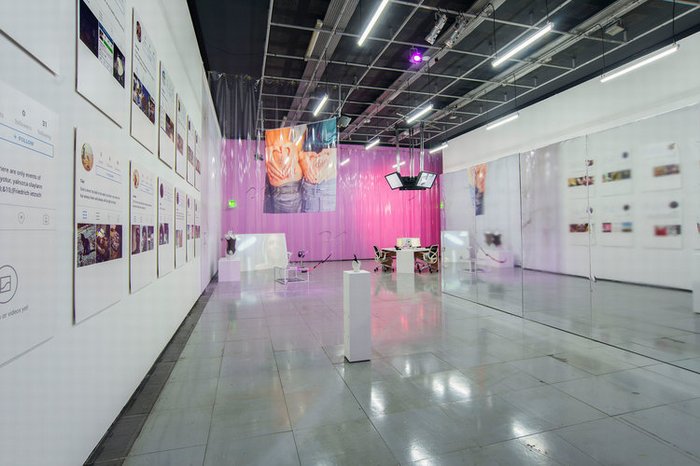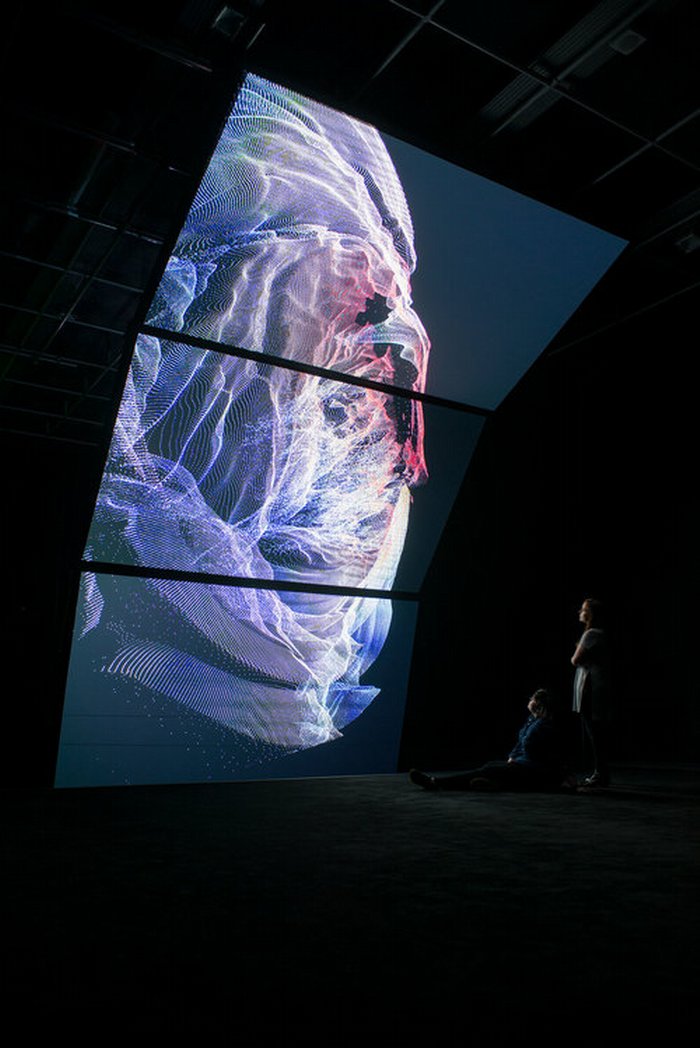
Hi Lesley, your the producer and curator at FACT, Foundation for Art and Creative Technology in Liverpool: what is it like investigating the relationship between the two, and what have you noticed about the types of arts produced using creative technologies and their differences to more traditional art?
To me, there is nothing more important right now. Even if you are terrified of technology, or don’t want to engage with it, it is vital to have that view (like all standpoints) interrogated and dissected, and have it reflected back to you. We live in a moment filled with uncertainty, questions of authenticity, and a worry about how quickly technology is advancing: it is the perfect atmosphere in which to create art. Any form of artistic practice thrives in this unpredictable realm, but media art (as it is known less and less) is certainly taking its place at the forefront of tackling these issues face to face. We are at a moment when the more ‘traditional’ visual arts have begun to look towards those who might have previously been considered ‘new media artists’ to articulate the liminal spaces in which we increasingly find ourselves.
Can you tell us more about the origins of FACT and the evolution to the Liverpool institution it is today?
The essence of FACT began in 1985 when two students (Josie Barnard and Lisa Haskel) launched ‘Merseyside Moviola’, an occasional project for screening independent, experimental film and video work.
They were then joined by Eddie Berg (FACT’s founding Director) in 1987, and established Video Positive, a biennial festival for new media. A major part of the artistic heritage of Liverpool, the festival took place at venues across the city, and formed the basis of our on-going commitment to new and emerging media art forms as well as continual collaboration. This festival spirit very much lives on in the modern interaction of FACT: we are committed to remaining reactive and flexible so that our programme not only displays high-quality works of art (by artists at every stage of their careers) but so it always feels relevant, vibrant, and engaging.
Another huge element in FACT’s development was Moviola’s Collaboration Programme. Built on an ethos of crowdsourcing, knowledge-sharing and joint idea generation, this programme of work brought together communities and artists on hundreds of collaborative creative projects, and remains at the very heart of all FACT's work with young people, schools, communities and families today.
In 2003, we opened our building on Wood Street. The building was the city's first purpose built cultural project for over 60 years and remains a vibrant flagship in the redevelopment of the surrounding area. This location is very important to us, as the space (in a very diverse manner) has brought a lot to the city: I can say, as a long-term inhabitant! We are continually committed to explore ways to engage, and collaborate with, our local audiences whilst retaining our international partnerships and programme.

LaBeouf, Ronkko & Turner. TIOUCHMYSOUL, 2015. Performance view. (Follow, FACT, 2015). Courtesy Brian Slater
Throughout the year FACT runs a series of exhibitions across its galleries, what is the process like when deciding upon an exhibit?
In truth, it varies: we develop and produce a wide range of exhibitions of many different types. Some begin as internal projects with artists by whom the curatorial team (including the Director) are excited and want to showcase in monographs, or with whom we can make an interesting and relevant thesis show. These artists can be at any stage of their careers - we work a great deal with emerging or newly established practitioners- as long as we feel they are making important work which resonates with our artistic strategy. Other shows begin life as projects in collaboration with other galleries, curators or organisations who share the same ethos, approach or outlook as FACT. These shows are always very fun because they bring a whole new wealth of expertise and experience into the spaces and gives us a chance to work with a wide range of subject matters and materials.

Installation view. Shona Illingworth, Lesions in the Landscape, FACT, 2015. Courtesy Jon Barraclough.
So 2016 had a host of wonderful exhibitions, but which ones have been your personal highlights?
For me, the year began with the end of the first named curatorial project of mine at FACT, Follow (fact.co.uk/follow). The show had began in December and focused on the ways in which social media affects our identity and how artists are dissecting and problematising this through performance, video, and even the creation of new software. We worked with a host of amazing artists, including a major commission by Cecile B. Evans (http://cecilebevans.com/) which is very close to my heart and ended up becoming part of a feature length work (http://bb9.berlinbiennale.de/participants/evans/) shown in Berlin Biennale 9 (bb9.berlinbiennale.de/) last year. Another great highlight was working with the Japanese audio-visual artist Ryoichi Kurokawa (ryoichikurokawa.com) who created a new immersive installation mapping the life cycle of a huge, sun-like star called unfold (https://vimeo.com/159521082) . This has been touring internationally ever since it was shown in Liverpool: the work is literally breathtaking, and was one of the most exciting and interesting processes so far during my time at FACT. I learned more about speakers and astrophysics than I thought possible!

Installation view 3, Ryoichi Kurokawa, unfold (FACT, 2016). Courtesy Jon Barraclough
Can you give us any hints as to what’s coming up over the next 18 months and which ones we definitely shouldn’t miss!
We have just opened a very timely major new group show, which I’ve been working on for around 2 years. It is called How much of this is fiction. (fact.co.uk/hmotif) and looks at the artist as trickster and prankster. It takes things like fake news, alternative facts and our current landscape of ‘post-truth’ politics as a starting point and thinks about the ways in which artists such as Morehshin Allahyari (morehshin.com), The Yes Men(yeslab.org) and Arabian Street Artists (hebaamin.com) imagine a more utopic world in which politicians and corporations are held responsible for their actions, and in which cultural monuments can never be truly destroyed but rather recast in a new, more personal light.
I am also very, very excited to be working with the LA-based filmmaker Wu Tsang (wutsang.com) at the end of the year as we explore the concept of the arts organisation, and visual art itself, as a refuge. The show will be a retrospective, but also include a new commission which is currently in development. There is a very strong element of politics and storytelling, and the importance of fiction, running throughout the year: concepts which I have spent my career thinking, writing, and producing around. So a very interesting year for me, and for our audiences, who seem to be quite energised by the programme so far - I’ve already had some very lively discussions!

Installation view. Yin-Ju Chen, Action at a Distance, 2015. (No Such Thing As Gravity, FACT, 2016.) Courtsey Stephen King
FACT also runs FACTlab, a series of hands-on activities throughout the year, tell us more about the kinds of things explored in the workshops and which ones are coming up?
FACTLab (http://www.fact.co.uk/get-involved/factlab.aspx) is becoming very important to our programme, and to FACT’s structure moving forward. It began life as a ‘pop-up’ space and series of workshops but has since developed to having it’s own space in the building, and a much stronger, and regular presence in our output. It has become a core part of our learning programme (for children, families, and adults alike) and provides a dedicated area in which we are able to host artists in residence from all over the world.
It has already allowed us to develop new works of art, host classes about digital literacy and hands-on tech skills (with groups like Liverpool Girl Geeks)[http://www.fact.co.uk/news-articles/2016/08/meet-liverpool-girl-geeks.aspx] and we are discovering how exciting building a maker community around an arts space can be. Having the skills in-house, and creating the space (both physically and programmatically) for research, prototyping, beta-testing and development has been an incredible learning experience which has affected all of our programme. It is very exciting (from a curatorial, and a political level) to be able to not only just create a discursive space in the galleries, which focuses on a certain issue, but also be able to create a co-learning space which helps to develop the skills necessary to combat, explore, or engage with, those same concepts.

We Buy White Albums (FACT, 2015)
FOR MORE INFO ON FACT VISIT www.fact.co.uk
INTERVIEW by ART WEEK / HANNAH SMITH

